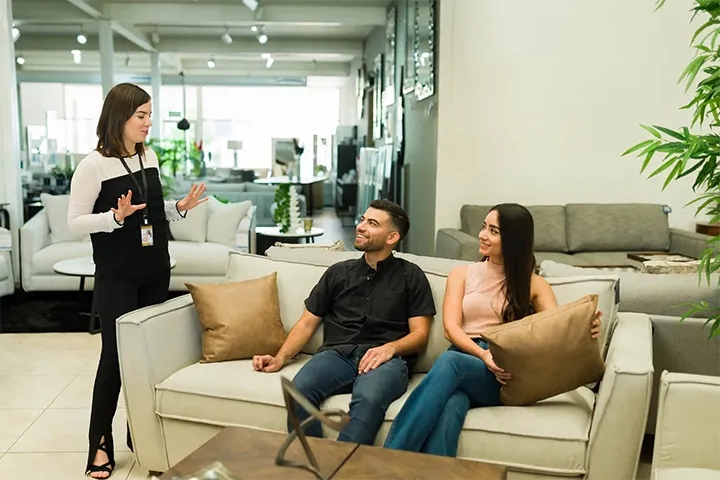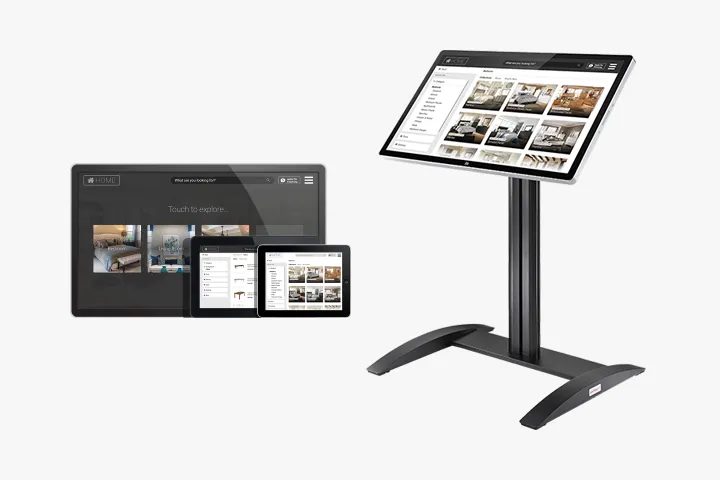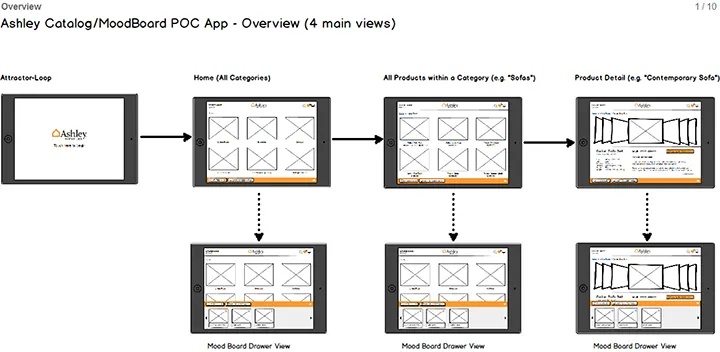Ashley Kiosk Overview
The Ashley Furniture Kiosk increases guest-to-customer conversions by offering a quick and convenient way to browse store inventory, giving sales associates more time to engage with customers. I collaborated closely with the kiosk technology provider to design an interface that mirrors the familiar e-commerce experience but is solely focused on quick discovery and checkout and tailored specifically to display each store’s unique inventory.
The Challenge
During peak shopping hours and events, in-store sales associates often found themselves overwhelmed by the volume of guests. To alleviate this pressure, a support system was needed to assist shoppers with browsing and answering common questions, allowing associates to focus on closing sales with customers ready to check out.
Enter the Ashley Kiosk. This kiosk technology enables shoppers to:
- Quickly locate items without having to navigate the store.
- Access answers to common questions independently, reducing reliance on sales associates.
- Shop at their own pace, providing an autonomous shopping experience tailored to their preferences.

Interviews
Prior research revealed that nearly half of shoppers preferred not to be approached by sales associates. This tendency was particularly evident among younger customers, who are accustomed to using technology for decision-making. Additionally, older shoppers, who have often encountered aggressive sales tactics while shopping for big-ticket items, expressed a preference for a digital assistant in-store.
To gain deeper insights, we conducted interviews with customers and sales associates from select locations. Here are some key pieces of feedback from customers:
“We never know what we want until we see it.”
“I don’t feel like I’m seeing all the options available because everything is so spread out.”
“I like shopping online, but it’s different from being in the store.”

Technology Review
After evaluating demos from various vendors, we identified a company that met all our requirements. Our review group included three members from key teams: UX, development, product management, IT (responsible for store hardware), and customer care.
The selected company offered a range of digital assistance options for stores, including:
- Large display stand-alone kiosk
- Large display for wall mount
- Smaller table-top displays
- Tablets to be used by sales associates
- An app for desktop usage
- API for integrating with existing sales apps

Additional Benefits
Other benefits this technology provides are
- Three ways to make applying for financing
- The ability to build and project customer mood boards
- Checkout capabilities for third-party products not delivered by Ashley
Given Ashley Furniture’s licensee model, stores that carry multiple furniture brands can also access inventory from non-Ashley HomeStore websites.

Planning
At this stage, we developed low-fidelity wireframes and user flows to explore ideas and collaborate with the hardware provider for compatibility. This process also involved coordinating with developers to address both backend services and front-end development requirements.
I worked closely with the merchandising department to streamline the navigation taxonomy. I also selected images from our photo assets to represent the main categories. While the e-Commerce site features category landing pages, the images there were in a different format and did not integrate well with the kiosk interface. Ultimately, the kiosk design focuses on the essentials, enabling customers to quickly locate the items they need.

Testing and User Surveys
The high-fidelity wireframes were well-received by both customers and sales associates. We selected pilot stores to gather additional feedback and test the platform’s stability.
To gain insights for any necessary adjustments, we implemented in-session surveys. These surveys consisted of a quick three-step questionnaire:
“How do you like the kiosk shopping experience?”
“Do you prefer using the kiosk or browsing the store?”
“Is there any feedback that you can provide to make this a better experience?”
Questions 1 and 2 used a 5-option radio button format, while the third question allowed for open-ended responses in a text area.
To encourage survey participation, stores offered a 5% discount on items purchased during that session, which also helped boost sales.

Final Thoughts
Overall, I was pleased with the results, particularly the collaboration between the in-store sales teams, the Ashley E-Commerce teams, and the third-party hardware provider to bring this project to life. We also made additional updates based on feedback from the pilot program.
